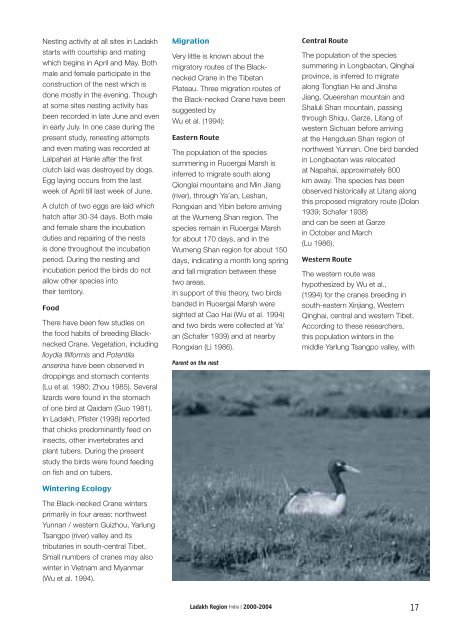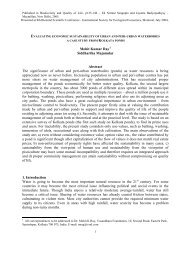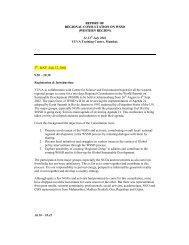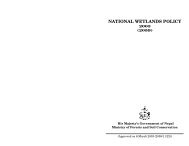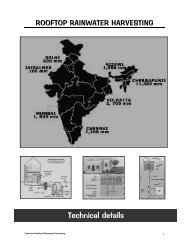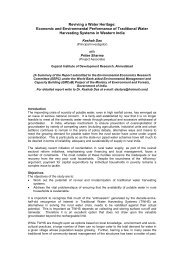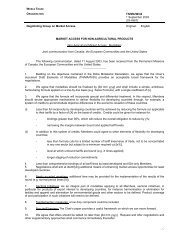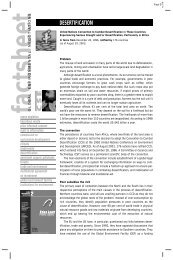Black-necked Crane - WWF-India
Black-necked Crane - WWF-India
Black-necked Crane - WWF-India
You also want an ePaper? Increase the reach of your titles
YUMPU automatically turns print PDFs into web optimized ePapers that Google loves.
Nesting activity at all sites in Ladakh<br />
starts with courtship and mating<br />
which begins in April and May. Both<br />
male and female participate in the<br />
construction of the nest which is<br />
done mostly in the evening. Though<br />
at some sites nesting activity has<br />
been recorded in late June and even<br />
in early July. In one case during the<br />
present study, renesting attempts<br />
and even mating was recorded at<br />
Lalpahari at Hanle after the fi rst<br />
clutch laid was destroyed by dogs.<br />
Egg laying occurs from the last<br />
week of April till last week of June.<br />
A clutch of two eggs are laid which<br />
hatch after 30-34 days. Both male<br />
and female share the incubation<br />
duties and repairing of the nests<br />
is done throughout the incubation<br />
period. During the nesting and<br />
incubation period the birds do not<br />
allow other species into<br />
their territory.<br />
Food<br />
There have been few studies on<br />
the food habits of breeding <strong>Black</strong><strong>necked</strong><br />
<strong>Crane</strong>. Vegetation, including<br />
lloydia fi liformis and Potentila<br />
anserina have been observed in<br />
droppings and stomach contents<br />
(Lu et al. 1980; Zhou 1985). Several<br />
lizards were found in the stomach<br />
of one bird at Qaidam (Guo 1981).<br />
In Ladakh, Pfi ster (1998) reported<br />
that chicks predominantly feed on<br />
insects, other invertebrates and<br />
plant tubers. During the present<br />
study the birds were found feeding<br />
on fi sh and on tubers.<br />
Wintering Ecology<br />
The <strong>Black</strong>-<strong>necked</strong> <strong>Crane</strong> winters<br />
primarily in four areas: northwest<br />
Yunnan / western Guizhou, Yarlung<br />
Tsangpo (river) valley and its<br />
tributaries in south-central Tibet.<br />
Small numbers of cranes may also<br />
winter in Vietnam and Myanmar<br />
(Wu et al. 1994).<br />
Migration<br />
Very little is known about the<br />
migratory routes of the <strong>Black</strong><strong>necked</strong><br />
<strong>Crane</strong> in the Tibetan<br />
Plateau. Three migration routes of<br />
the <strong>Black</strong>-<strong>necked</strong> <strong>Crane</strong> have been<br />
suggested by<br />
Wu et al. (1994):<br />
Eastern Route<br />
The population of the species<br />
summering in Ruoergai Marsh is<br />
inferred to migrate south along<br />
Qionglai mountains and Min Jiang<br />
(river), through Ya’an, Leshan,<br />
Rongxian and Yibin before arriving<br />
at the Wumeng Shan region. The<br />
species remain in Ruoergai Marsh<br />
for about 170 days, and in the<br />
Wumeng Shan region for about 150<br />
days, indicating a month long spring<br />
and fall migration between these<br />
two areas.<br />
In support of this theory, two birds<br />
banded in Ruoergai Marsh were<br />
sighted at Cao Hai (Wu et al. 1994)<br />
and two birds were collected at Ya’<br />
an (Schafer 1939) and at nearby<br />
Rongxian (Li 1986).<br />
Parent on the nest<br />
Central Route<br />
The population of the species<br />
summering in Longbaotan, Qinghai<br />
province, is inferred to migrate<br />
along Tongtian He and Jinsha<br />
Jiang, Queershan mountain and<br />
Shaluli Shan mountain, passing<br />
through Shiqu, Garze, Litang of<br />
western Sichuan before arriving<br />
at the Hengduan Shan region of<br />
northwest Yunnan. One bird banded<br />
in Longbaotan was relocated<br />
at Napahai, approximately 800<br />
km away. The species has been<br />
observed historically at Litang along<br />
this proposed migratory route (Dolan<br />
1939; Schafer 1938)<br />
and can be seen at Garze<br />
in October and March<br />
(Lu 1986).<br />
Western Route<br />
The western route was<br />
hypothesized by Wu et al.,<br />
(1994) for the cranes breeding in<br />
south-eastern Xinjiang, Western<br />
Qinghai, central and western Tibet.<br />
According to these researchers,<br />
this population winters in the<br />
middle Yarlung Tsangpo valley, with<br />
Ladakh Region <strong>India</strong> | 2000-2004 17


